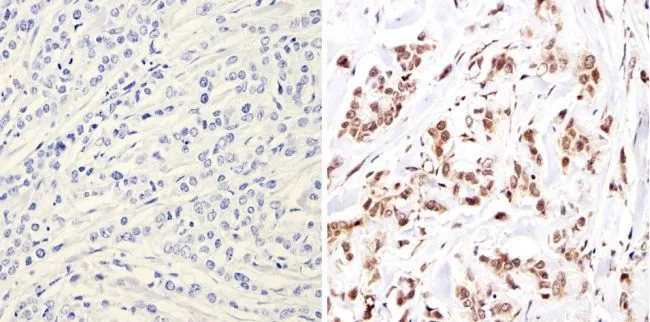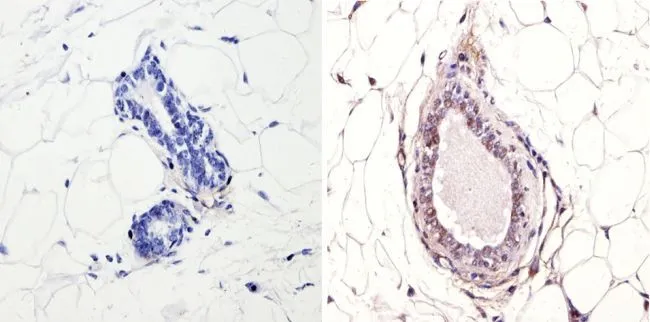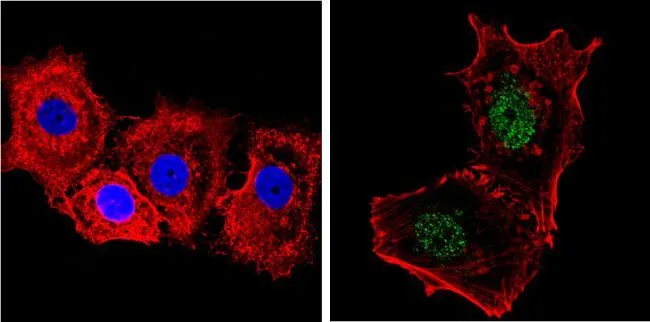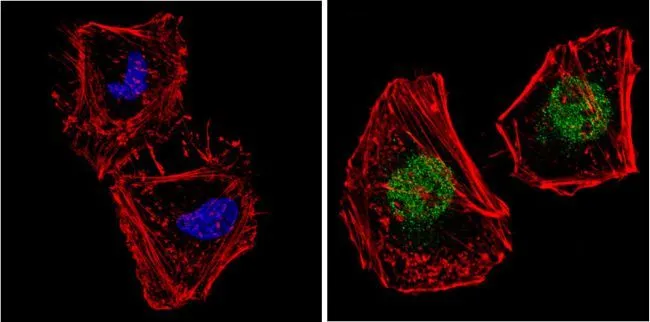
IHC-P analysis of human breast carcinoma tissue using GTX23482 NCOR1 antibody. Right : Primary antibody Left : Negative control without primary antibody Antigen retrieval : 10mM sodium citrate (pH 6.0), microwaved for 8-15 min Dilution : 1:200
NCOR1 antibody
GTX23482
ApplicationsFlow Cytometry, ImmunoFluorescence, ImmunoPrecipitation, Western Blot, ChIP Chromatin ImmunoPrecipitation, ImmunoCytoChemistry, ImmunoHistoChemistry, ImmunoHistoChemistry Paraffin
Product group Antibodies
ReactivityHuman, Mouse
TargetNcor1
Overview
- SupplierGeneTex
- Product NameNCOR1 antibody
- Delivery Days Customer9
- Application Supplier NoteWB: 1 microg/ml. ICC/IF: 1:100-1:500. IHC-P: 1:200-1:1000. FACS: 3-5 microg/106 cells. *Optimal dilutions/concentrations should be determined by the researcher.Not tested in other applications.
- ApplicationsFlow Cytometry, ImmunoFluorescence, ImmunoPrecipitation, Western Blot, ChIP Chromatin ImmunoPrecipitation, ImmunoCytoChemistry, ImmunoHistoChemistry, ImmunoHistoChemistry Paraffin
- CertificationResearch Use Only
- ClonalityPolyclonal
- Concentration0.7 mg/ml
- ConjugateUnconjugated
- Gene ID20185
- Target nameNcor1
- Target descriptionnuclear receptor co-repressor 1
- Target synonyms5730405M06Rik; A230020K14Rik; mKIAA1047; N-; N-CoR; N-CoR1; nuclear receptor corepressor 1; retinoid X receptor-interacting protein 13; RIP13; Rxr; Rxrip13
- HostRabbit
- IsotypeIgG
- Scientific DescriptionSteroid and thyroid hormones and retinoic acid regulate a complex array of gene expression activity via intracellular receptor transcription factors belonging to the ligand-dependent nuclear receptor superfamily. Adding to the complexity of function of these transcription factors are associated proteins known as coactivators and corepressors which, as their names suggest, enhance or depress transcription activity of the nuclear receptor with which they associate. Silencing mediator of retinoic acid & thyroid hormone receptor (SMRT) and nuclear receptor corepressor (N-CoR) are related transcriptional corepressors which contain two distinct domains capable of interacting with unliganded nuclear receptors to repress their basal transcriptional activity.
- ReactivityHuman, Mouse
- Storage Instruction-20°C or -80°C,2°C to 8°C
- UNSPSC12352203



